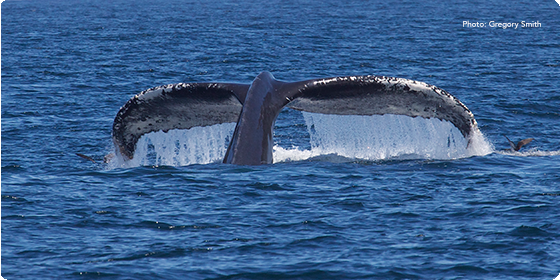
On April 21, 2021, the National Marine Fisheries Services (NMFS)—a branch of the National Oceanic and Atmospheric Administration—published a final rule in the Federal Register that designates critical habitat areas for humpback whales in the Pacific Ocean. The rule is the result of a lawsuit filed by environmental nonprofit organizations in 2018 over protections for Pacific humpback whales under the Endangered Species Act (ESA).
The ESA is a federal statute that provides stringent protections for species that are in danger of becoming extinct, which are called “endangered species,” as well as protections for species that are likely to become endangered within the foreseeable future, known as “threatened species.” 16 U.S.C. § 1532. In order to be protected under the ESA, a species must be added to the federal list of endangered and threatened wildlife and plants by NMFS or the U.S. Fish & Wildlife Service (FWS) based on a combination of factors, including the best scientific information available and feedback from the general public. Once a species is listed, NMFS or FWS must then identify the species’ habitat—a process the statute refers to as “designating critical habitat”—which in turn receives enhanced protection under the ESA. 16 U.S.C. § 1533(a)(3).
Humpback whales were listed and protected under the ESA on a species-wide basis until 2016. Then, in September of that year, NMFS finalized a rule that removed the species-wide listing in favor of listing distinct population segments (DPSs)—unique subgroups of the species that, in the case of humpback whales, are categorized on a geographic basis. In the 2016 rule, NMFS identified 14 humpback DPSs listing four as endangered and one DPS as threatened. The agency determined that the other nine DPSs did not warrant listing under the ESA. 81 FR 62260. The rule notably concluded that critical habitat was not yet determinable for the five listed DPSs, including three that can be found in U.S. waters, which afforded the agency another year to make the designations.
But NMFS still had not designated any critical habitat for the five listed humpback DPSs by March 2018, prompting a lawsuit by the Center for Biological Diversity, Turtle Island Restoration Network, and the Wishtoyo Foundation. The plaintiffs requested court-ordered deadlines for NMFS to issue critical habitat designations for the three listed humpback DPSs found in U.S. waters. See Center for Biological Diversity et al. v. National Marine Fisheries Service, et al., No. 3:18–cv–01628–EDL (N.D. Cal.). A settlement agreement between the parties was reached with the approval and oversight of the court, and later negotiations yielded an April 2021 deadline for NMFS to issue a final rule with the critical habitat designations. 86 FR 21082.
These proceedings culminated in the publication of the final rule on April 21, and the rule itself identified more than 200,000 nautical square miles (nmi²) of U.S. waters as critical habitat for the three humpback DPSs. More specifically, NMFS designated almost 60,000 nmi² off the coast of Alaska as critical habitat for the endangered Western North Pacific DPS, as well as roughly 48,000 nmi² of marine habitat off the coasts of Washington, Oregon, and California for the endangered Central America DPS. Id. at 21147. Meanwhile, the rule also designates more than 116,000 nmi² of U.S. waters along the coasts of Alaska, Washington, Oregon, and California as critical habitat for the threatened Mexico DPS. Id. As the maps included in the final rule indicate, there is some overlap between the areas identified as critical habitat for each DPS. Id. at 21155-57.
Once the final rule becomes effective on May 21, all federal agencies must ensure that any action that they authorize, fund, or carry out is not likely to adversely affect any habitat area now identified as critical for the three humpback DPSs. 16 U.S.C. § 1536(a)(2). Additionally, if a federal agency determines that any such action is likely to destroy or adversely modify humpback habitat in the newly identified areas, it must consult with NMFS to identify reasonable and prudent alternatives to the action that would avoid destruction or adverse modification. Id. § 1536(a)(4).
Although the designations’ effect on specific projects is not yet clear, the publication of this final rule signifies yet another legal splash in the increasingly active fight over whale conservation efforts across the US. Anyone interested in learning more can read about how the North Atlantic Right Whale’s ESA listing recently impacted the Massachusetts lobster fishery in the National Sea Grant Law Center Blog post.












